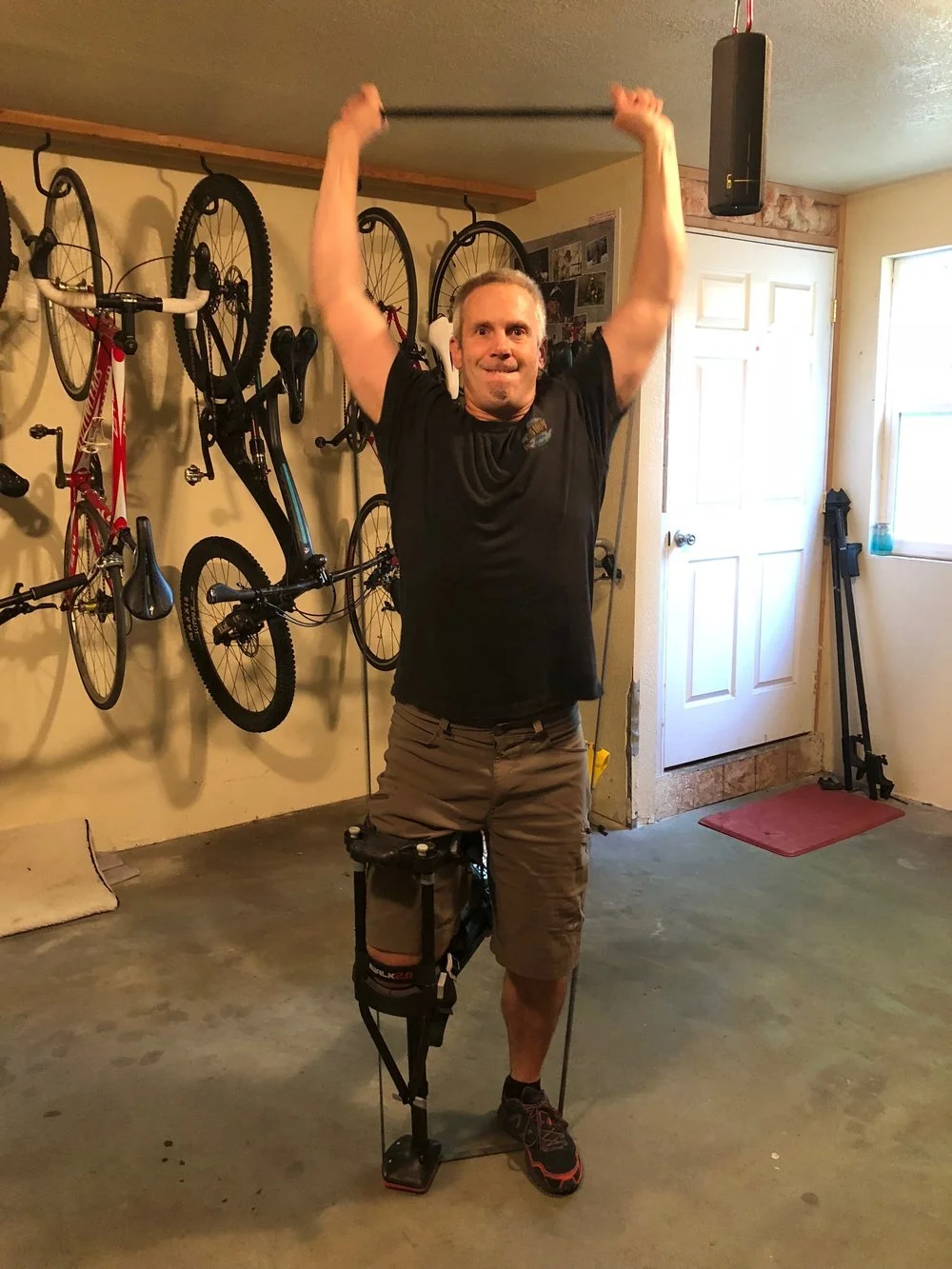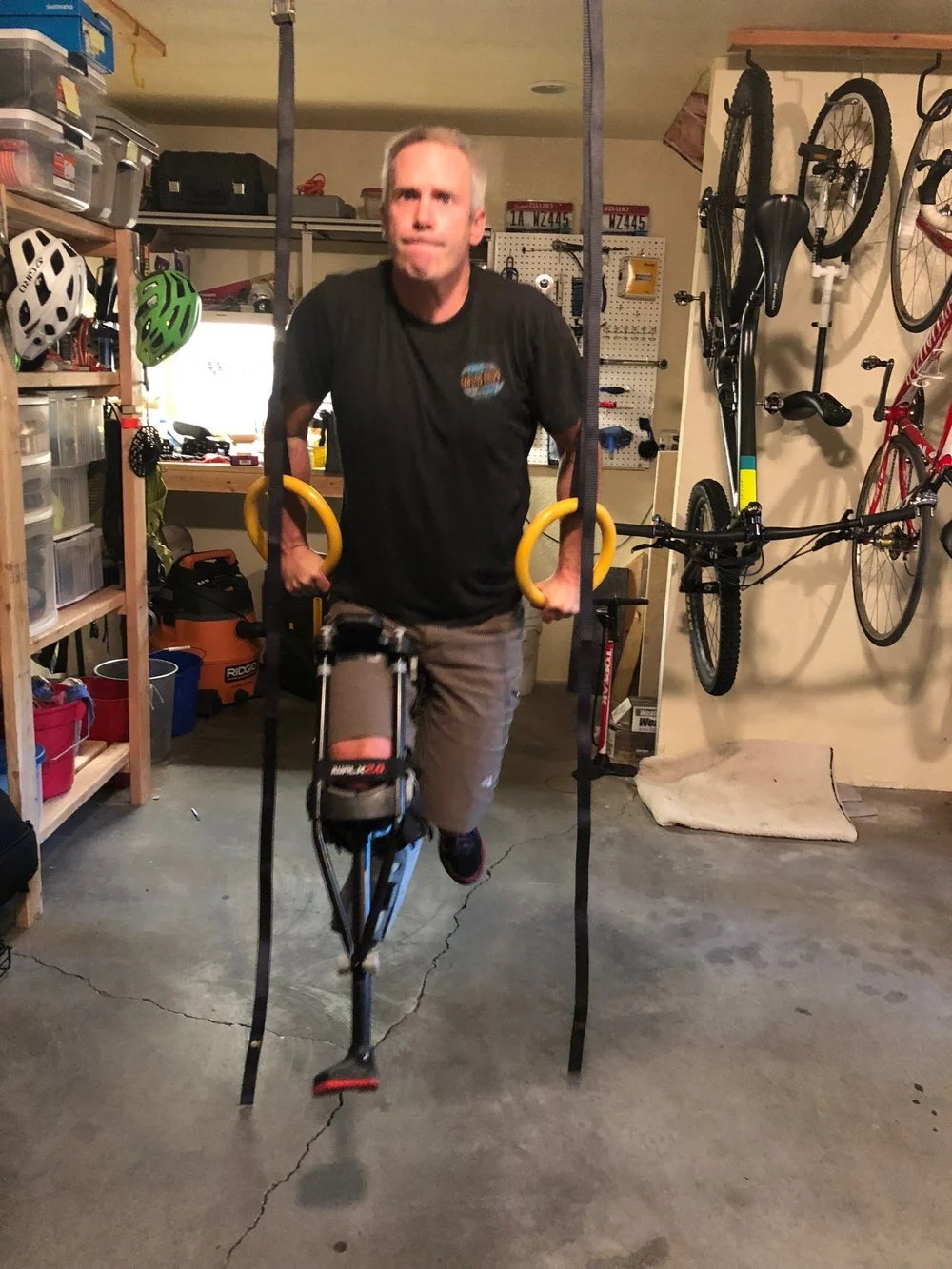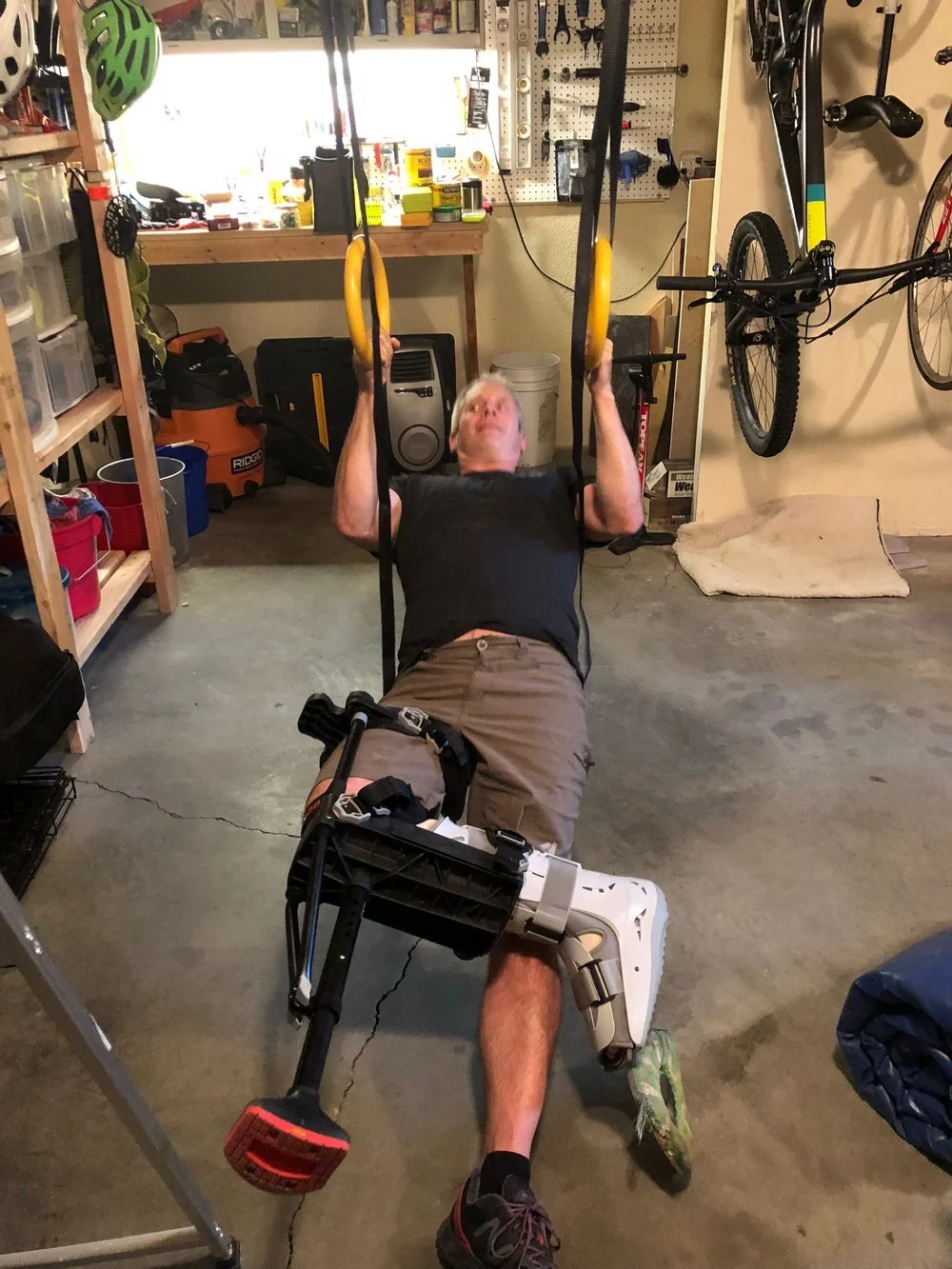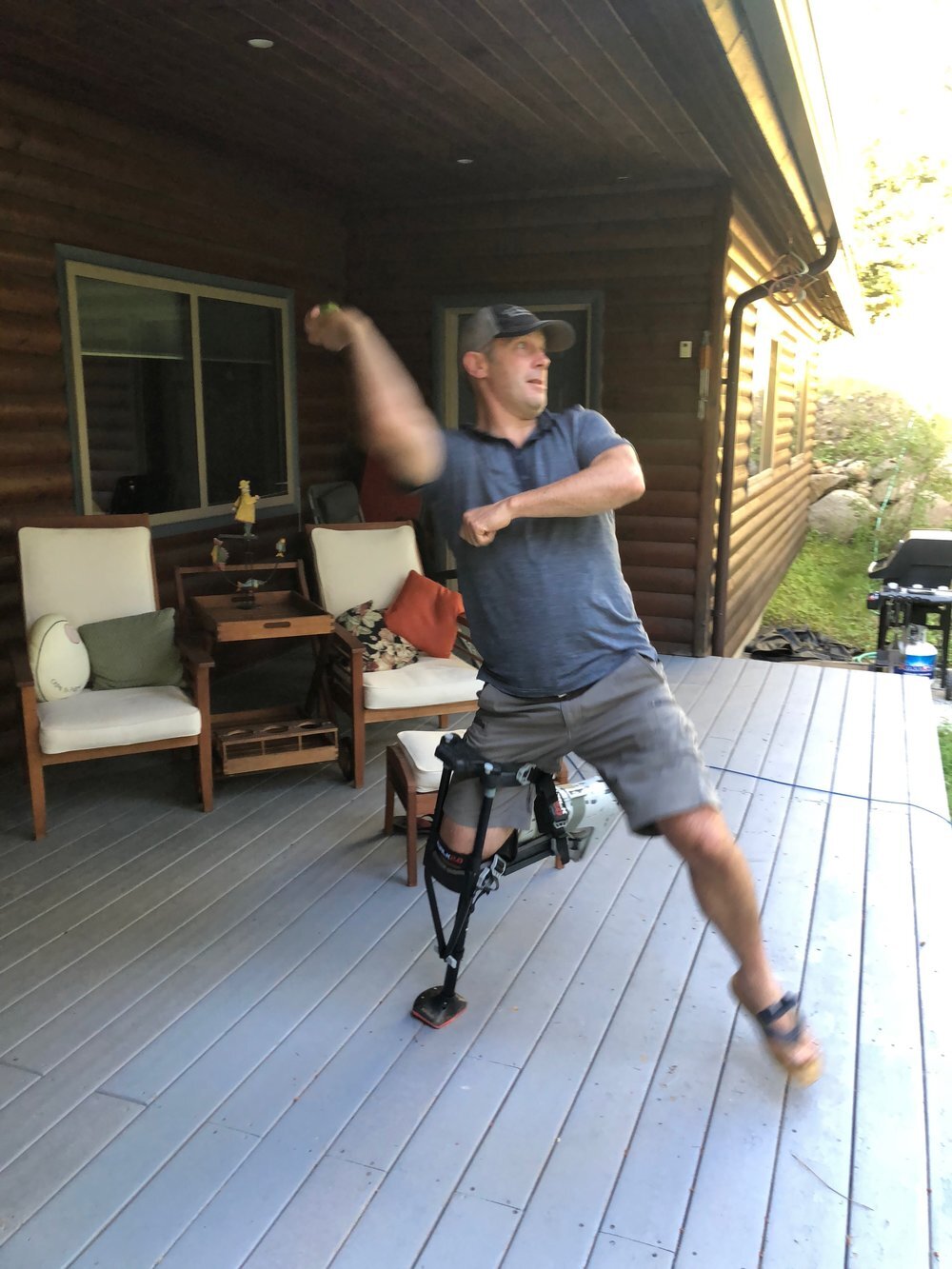iWalk revolutionizes mobility for people on crutches
This article is eighth in a series that chronicles my experience following Lisfranc injury.
Part 1: Learning about the scary life-altering potential of a Lisfranc fracture
Part 2: Setting goals for Lisfranc recovery gives optimism, determination and purpose
Part 3: Surgery day and learning about the Arthrex InternalBrace
Part 4: Lisfranc recovery is slower and tougher than imagined
Part 5: Relearning to walk and ride a bike after Lisfranc surgery
Part 6: The 215-mile Lisfranc recovery test
Part 7: Looking back a year later. What’s fixed and what isn’t.
Part 8: Did the iWalk crutch speed my recovery?
When I suffered a traumatic foot injury in 2018, I hadn’t been on crutches in more than 20 years. I’d never even seen a knee scooter and certainly hadn’t heard of the iWalk.
Crutches underwent significant innovation in those two decades, and I was fortunate to discover the unparalleled benefits of the iWalk during the three months I used it.
The bottom line is simple: For those recovering from foot and ankle injuries, the iWalk is far and away the most innovative and versatile crutch available.
Learning to use the iWalk
The iWalk (click here to check it out on Amazon) is a crazy-looking contraption, but its utility quickly becomes clear.
Easy hiking is well within the iWalk’s abilities.
Like most people who haven’t thought critically about crutch design, I obtained a pair of traditional crutches in the days after I suffered a Lisfranc Fracture in June 2018. After a few days of frustration at my lack of ability, a friend suggested I check out the iWalk. I immediately recognized it would free my hands and facilitate independence on a level not possible with traditional crutches.
Uneven terrain? No problem. the iWalk can handle it.
Learning to use the iWalk was pretty easy, but not totally glitch-free. It took about a week to safely strap it to my leg and take it off without losing my balance. More important, it took a little more than two weeks for the muscles in my legs to become attuned to subtle new movements. Your whole uninjured leg does more work than it’s used to, and the hip on your injured leg does as well. Using the iWalk is its own form of training, however, and all of the affected muscle groups quickly gained enough strength to undertake some pretty cool adventures for a guy suffering a serious foot injury.
My bottom-line advice is to take it slow. The iWalk will make countless activities possible, but it takes patience learning to put it on and take it off while allowing your muscles to get stronger and balance more acute.
iWalk tips and tricks
At first I only used the iWalk around the house, but within days was moving around the yard and tending to the garden. After a couple weeks, I was able to take the dog for a walk around a two-block circuit. By the end of two-plus months I was able to get myself in and out of the car; hike a couple miles; attend concerts; work out using bands, dumbbells and rings; climb a ladder and more.
Here’s a list of some of the activities the iWalk made possible and how I went about learning them:
You probably won’t find climbing a ladder in the iWalk marketing literature, but it’s doable and decently safe.
Household and work chores: While not as sexy or interesting as some of the activities listed below, maintaining your normal chores around the house and at work is crucial to your mental health, sense of purpose and productivity. Examples are numerous and seemingly innocuous until you consider that with traditional crutches none of them are possible: carrying your laptop to your desk to charge the battery, washing dishes, taking out trash, feeding the dog, cleaning the kitty litter, carrying a notebook into a meeting at work and many more.
Stairs: One of the early and ongoing challenges of using the iWalk for me was climbing and descending stairs. Without an articulating knee, you must step up or down each step using your uninjured leg or swing the iWalk around the lip of each step using your hip muscles. This puts additional strain on the quadriceps of your uninjured leg and the gluteus medias, piriformis, hip flexors and other muscles in your injured leg. With practice, though, it’s doable and safe.
Biking: Pretty early in my recovery I discovered I was able to put the iWalk in a bicycle saddle bag or pannier and ride on gentle terrain using a walking boot. To be very clear, this is an activity my surgeon forbade; I just offer it here to relay what’s possible. During a trip to Bend, Oregon, when friends were off mountain biking, I was able to ride my cruiser bike across town to the whitewater park and sit on a sunny patch of grass before returning to the bike and taking myself for coffee. That’s a kind of independence not possible with traditional crutches.
Hiking: The iWalk isn’t called the iHike for good reason. There’s no way you’re going to hike more than a few miles without putting a lot of unnecessary strain on the hip of your injured leg. However, after I’d been using the iWalk about three weeks I drove to a trailhead and hiked a little more than a mile each way to a beautiful mountain vista where wildflowers and sunshine brightened my mood.
Workouts: One of the first things I did when I was injured was build a workout program I’d be able to maintain during my recovery. The iWalk was integral to that program and proved even more useful than anticipated. Using bands and dumbbells, I was able to perform standing shoulder presses, lateral raises, curls and triceps extensions. Using rings I was able to do push-ups, rows, pull-ups and dips. My uninjured leg also grew incredibly strong just from using the iWalk. I was able to do 20 or more one-legged pistol squats; I’d be surprised if I can do a small fraction of that now. Finally and importantly, my injured leg stayed active in ways it wouldn’t have if I’d been using traditional crutches. Nerves stayed engaged and boosted blood flow, speeding recovery.
Handyman work: I never told my surgeon, and I can’t imagine she would have condoned it, but I continued to do handyman work around the house, including jobs like cleaning gutters, changing light fixtures, and repairing a garage door ceiling mount that required using a ladder.
Limitations of the iWalk
“The iWalk is easy, comfortable, efficient and affordable. In no small way, the iWalk made my three months of recovery tolerable like no other invention could have.”
While the iWalk is clearly revolutionary, it may not be for everybody. My surgeon was fairly progressive and had some reservations about it. If I was a senior or out-of-shape person with wobbly balance, she’d discourage its use.
While I’m not convinced it’s a bad idea for people fitting those descriptions, her caution is worth noting for people in those demographics. When in doubt, contact your own physician for advice.
The only scenario where I found the iWalk more ill-equipped than traditional crutches was going to the bathroom in the middle of the night. It was simply too much hassle to put the thing on to walk 20 feet to the toilet. The solution was pretty simple. I kept a pair of traditional crutches next to the bed, and that’s where they stayed for the duration of my recovery.
I’ve read elsewhere on the internet that people have found knee scooters more convenient for around-the-house movement. While they might be comfortable for taking the weight off your armpits and wrists, knee scooters still require use of your hands and arms, negating their use for something as simple as carrying a bag of groceries from one room to another.
Health benefits of the iWalk
The iWalk has obvious health benefits when it comes to staying active and maintaining a positive attitude during recovery from a foot or ankle injury. It makes normal life possible in ways traditional crutches simply can’t.
What’s less obvious is that the iWalk has been proven to engage the muscles of your injured foot while keeping it immobilized. This prevents muscle atrophy and promotes blood flow, which could accelerate the healing process, according to a study published in September 2020 by the American Orthopaedic Foot & Ankle Society.
I was proud of myself for setting goals and achieving most of them during my recovery, but in light of the new study realize the iWalk may have done more for me than help me stay active and positive. Using it to walk around actually kept my unused calf, quads and hamstrings working and blood flowing in my ankle and foot. With hindsight, it’s pretty easy to ask: how could that not accelerate your recovery?
History of the iWalk
The iWalk was invented more than 20 years ago by a fifth-generation farmer who refused to quit working while recovering from a foot injury. Built from wood and coined iWalkFree, the prototype found its way into the hands of orthopedists who helped vet the invention. The company, named for the original device, commenced production of the original aluminum and plastic model in 1999, and by 2000 it was distributed and in use in Canada, Europe and the United States.
Not satisfied resting on its laurels, iWalkFree refined the iWalk and launched iWalk2.0 in 2013 and the iWalk3.0 in spring 2021. The iWalk 2.0, the model I used for the duration of my injury, is made entirely of plastic, soft padding and nylon straps with quick-release buckles for easy on and off.
According to the company, the newer iWalk is easier to learn, more comfortable and more efficient—not to mention more affordable.
I don’t have a point of reference by which to measure those claims, but I’m more than happy to affirm that the iWalk is easy, comfortable, efficient and affordable. In no small way, the iWalk made my three months of recovery tolerable like no other invention could have.










